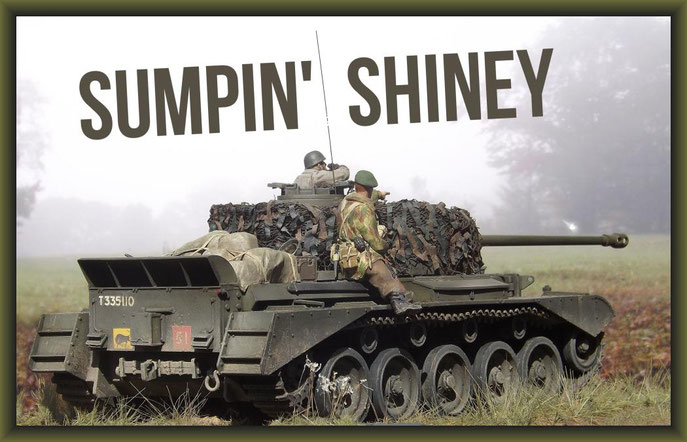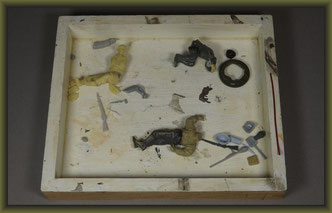Leese, Lower Saxony. 9th April 1945
Apart from the obvious - which I'll mention in the 'epilogue', how many things need a shuddering climax right at the end?
Most novels, operas, films and firework displays have them. In military history Waterloo springs to mind, but the vast majority of campaigns end in a slow drab fade.
In WWII Germany, the Soviets had their final Battle of Berlin. The U.S. took the lions share of the Fatherland and could at least boast the conquest of large famous cities and picturesque landscapes.
For the British 21st Army it was a different story. Suffering manpower shortages, they were shelved into the smaller northern area which is mostly flat with a wetter climate than the rest of the country. Not really a Hollywood 'Sound of Music' senario.
Good, there are a few cities there but these were largly surrendered without much trouble. Anyhow, as they mostly stood in the public eye for the 'pensioned-off' Kriegsmarine, their capture was received with something of a 'so-what' attiude at home. No Stalingrad earth shaking headlines here.
All this coupled with the fact that most people couldn't wait for it all to be 'done and dusted', it's little wonder that the reporting of the last weeks of fighting in this area went off like a damp squib. Despite this, it was a different story for the men on the ground. The German's own navy, airforce and armoured units may have been more historic than actual at this time but their surplus men and explosives were most certainly not. Massive shells and bombs were converted into land mines. These,when detonated, not only vaporized an advancing tank but also shifted the road it was driving on. Anti-tank weapons of all sorts took a heavy toll of AFV's that stuck out like sore-thumbs on the table top rural terrain. Knowing their own country well and having good vantage points over the plains made pin-point artillery 'stonks' simplicity in itself. Their snipers in such a senario were spoilt for targets and booby traps, as always, lurked in wait for the tired and unwary.
To the German civilian population, filled to the brim by years of mind-numbing propaganda, the allies were seen not liberators but invaders. Attacks by youths and women were not uncommon and even a geriatric could operate and fire a Panzerfaust.
The British did outthink and outfight their enemy in the end, but the final march was a costly one. With the end in sight caution became the byword, especially with the known German tendency to club together ad hoc units for surprise counter attacks - and one Arnhem was more than enough.
The road to the north German coast in April '45 was to include many savage smallscale battles - battles that pushed the butcher's bill far to high for the net result. What with no dashing cavalry charges on offer and the end of the war only weeks away … perhaps it was better, if not wiser, not to broadcast things too much.
However, there was something else in this neck of the woods that needed to be toned down.
On the east bank of the river Weser opposite the town of Stolzenau lies the village of Leese.
After suffering casualties within their precarious bridgehead, troops of the R.M. Commando attacked Leese in a circling movement. Linking up with Comet tanks from the 23rd Hussars (11 Armd Div) that were driving north, the village was taken and chase given to a retreating Hitler Youth battalion of the Waffen-SS.
It was about this time that they came across some odd-looking objects on railway wagons in a nearby wood. On closer inspection, they turned out to be the air raid wrecks of some of the notorious V2 rockets. The commandos secured the site along with a large group of scientists who, without the slightest intention of a Wagnarian last stand - surrendered quietly.
At this point things get a little shadey.
The scientists, being officers of the SS, were guilty of using slave labour from the concentration camps for their work. Even though the V2 turned out to be a costly folly, it's secrets were feverishly sought for the allies own rocket programs. There was even a special T-Force set up to care for these men of science who were fully aware of their technical bartering chips. The Omega of the story (and Alpha of another) was that their crimes were overlooked in exchange for their knowledge.
The Diorama:
The Comet tank was the best British tank of the war. Having a good balance of reliability, armour, speed and firepower. The fact that they saw combat too late in the war to take on German armour in any number must have been hugely frustrating for their crews. The men behind the steel had been forced constantly by British tank design, up till then, to play second fiddle to the panzers. With the exellent Centurion (prototype April '45) in the wings, the production run of the Comet was a short one.
With this in mind I couldn't resist putting a 'flash in the pan' on the engine deck.
As 1:35 plastic Comet kits go, Bronco has the only 'bright spark' on hand at the moment. As a model it's very basic but it's price is a bit 'salty'. Reminding me somewhat of Monty Python's legendary "stream of bats piss" that in contradiction also "shone out like a shaft of gold when all around was dark".
The commando figure, as you know, is a converted V.P. Para. The SS Officer (Italeri) I have flung into the 'sump' of a Wasserdurchlass or culvert along with his shiney deaths head cap badge.
Incidentaly, have you ever wondered why the Germans concentrated their energies on wonder weapons and super tanks rather than mass producing say, the quite effective Panzer IV H/G ?
Let me put it like this, if you were an engineer, scientist or another carrier of grey mass during the Third Reich, which front would you like to be sent to?
A. Mediterranean.
B. Western.
C. Russian.
D. Home.
Yes, I thought so. Better start designing lots of things then and … er, take as long as you like with the development.
The space projects of all countries today stem from Nazi rocket technology and therefore all have not a little blood on their hands. Still, it is perhaps a story of good coming from evil.
Here's a film about the advance around Leese:
Kampfstoff-Fabrik (Chemical weapons factory) Leese, Germany (April 1945)
British army and tank casualties:
Victory and Defeat? Perceptions of the British Army in Northwest Europe, 1944‒45
The V2:
Operation Backfire - A4 V2 German Rocket Documentary von Braun
So then, it's time for the 'shuddering climax' I mentioned at the beginning. You thought sex - I thought horse racing.
So, I s'pose I is now an hintellectual … now dat's whut I calls sumpin' shiney.
18.11.'19
British Cruiser Tank A34 Comet
Diorama 1:35 / Building Stages:
Stage 1:
The old version of the Bronco Comet I've had on the back-burner for some time now. So before it disappears into the void completly, I thought it's time to bring it down to earth – so to speak. The kit itself is good but a bit pricey, it also needs a few tweeks here and there.
The update list:
- Homemade resin wheel caps and spare track
- Tie-downs, handles, track guard bolts, periscope covers and drilled-out m.g. muzzles
- Commanders cupola hatch padding, rear jack handle and gun mantlet cover
The 'Zeitfenster' that I'm aiming for hails (or Halley's) from a place and time that has scarcely been recorded in British military history.
Why such a reluctance in broadcasting this last phase of the fighting in N.W. Europe ... ?
... maybe they had some bloody good reasons.
18.08.'19
Stage 2:
A trio consisting of middle-aged Verlinden, old Italeri and ancient Tamiya make up the figures.
My Comet has been the recipient of many test sprays during it's 'shelf-life' so just ignore the tone for now and we'll get down to the nitty-gritty. The stays have been formed on the mantlet prior to the tarp cover, missing flat iron and rivets has been added to the front inner fenders and the front upper hull armour has been "dremeled" to a cast texture.
Oh, I was almost caught out here - be aware of the gap at the rear of this plate, I think mine needs some more kitting.
22.08.'19
Stage 3:
Some stiff old greenstuff built up the tarp mass - apoxie sculpt for the surface:
The usual potpourri of minatures: V.P., rustic Tamiya and wonder o wonder … an Italeri Waffen SS figure (who says I don't like building 'em).
I'll leave you with a shot in the dark … black acrylic to balance it all out:
'Thinks', ... I'd better not forget to chop off that rear portside light.
03.09.'19
Stage 4:
I find it's always inviting to place a figure pointing at something on a diorama. It can underline a certain detail or problem, and an argument or order is hard to visualise without one.
As I've used this 'trick' more than once in my work and to avoid repetition, I strive to keep them to a minimum. However, for this job there's no way around it as it's being used to indicate something of relevance outside the normal framework - so to speak.
The last snaps of the Comet before it's flight path brings it onto…
… the dark side of the moon.
20.10.'19
 The
Gun Bucket
The
Gun Bucket





















































